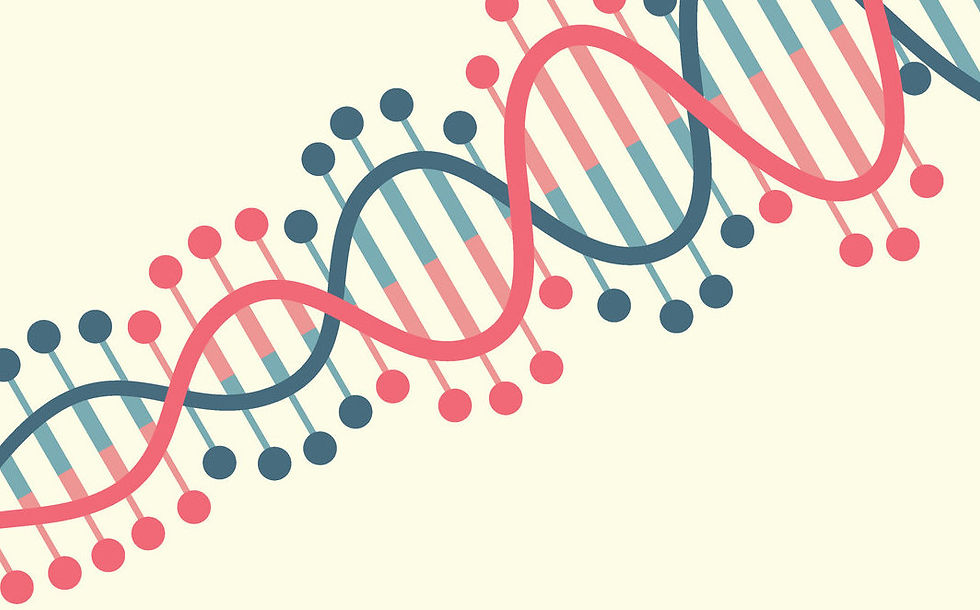Fingerprints: Not just on your hands
- Nasreen
- Nov 12, 2021
- 3 min read
Each one of the 7900 million humans on Earth is unique, not just in the way we look and think, but also in the patterns on our fingertips. These patterns, called fingerprints, are a unique signature for each one of us. However, our signatures are encoded not only at our fingertips but also deep inside our DNA.
Before we try to understand what this other signature is, let us look at what DNA is.

DNA, a complex chemical present in each cell of our body, is what defines our features and development. It is composed of certain chemicals called bases. There are four such bases called Adenine (A), Cytosine (C), Guanine (G), and Thymine (T). These bases like to pair up with each other, with A always bonding with T, and G always bonding with C. The base pairs so formed give the DNA its twisted ladder structure. There are 3000 million such base pairs in humans, all of which stay tightly packed inside each of our cells in the DNA structure.
About 99.9% of the DNA is almost the same for all humans with very little difference. There is, however, the remaining 0.1% or 3 million base pairs that are unique to each one of us. These 0.1% base pairs are spread out in our DNA in the form of sequences called minisatellites and microsatellites. The minisatellites are 10-60 base pairs long while microsatellites are only 2-5 base pairs long. The size and number of times these satellites are repeated is very different between individuals, more so in the case of microsatellites, giving each one of us a unique DNA fingerprint. In fact, so specific is our DNA fingerprint, that the chance that two individuals can have the same DNA fingerprint is only 1 in 10 million million (not a typing error!).
The technique of determining DNA fingerprints is called DNA fingerprinting, developed in 1984 by Alec Jeffreys, an English scientist. Depending on the DNA feature that is analyzed (minisatellites or microsatellites or both), the method used to determine it, and the purpose it is used for, DNA Fingerprinting is also known as DNA Profiling or Typing.
But why is our DNA fingerprint important?
Using a small amount of DNA-containing samples such as blood, saliva, hair root, bones, or teeth, and performing DNA fingerprinting on these samples, the identity of individuals can be established in various scenarios. Forensics is probably a field where DNA profiling has proven the most useful as it has helped to confirm the identity of persons involved in a crime. As microsatellites are inherited from parents, DNA fingerprinting can also be used to confirm blood relations.

The development of more sensitive technology to study microsatellites has also allowed DNA fingerprinting from old and partially damaged DNA samples. It proved famously useful in identifying members of a Russian royal family who had been executed in 1918. Years later, their bodies were exhumed in 1991 and DNA fingerprinting of the microsatellites using the bone samples proved that the remains indeed belonged to the royal family.
It is not just humans that possess unique DNA fingerprints. Other animals and plants all have unique DNA markers. The DNA fingerprinting technology has been used for wildlife conservation and in instances of wildlife crime, while in plants it has helped in identifying wild plant species from their cultivated varieties and in breeding specific varieties of ornamental plants. Unsurprisingly, DNA fingerprinting research with non-human animals and plants has tremendous scope including in forensic sciences, but they are not yet popular areas of research.
If the story of DNA fingerprinting intrigued you, you might want to read further on how it helped in identifying a King 500 years later, buried under a car park, or in solving several murder mysteries.
Sources and further reading:
Image 1: Double helix DNA by Shivam Thapliyal, for The Body Builders written by Supriya Nair, supported by CISCO, published by Pratham Books (© Pratham Books, 2019) under a CC BY 4.0 license on StoryWeaver. Read, create and translate stories for free on www.storyweaver.org.in
Image 2: Adapted from "A simplified model of DNA" at Klexikon.de and "DNA Fingerprinting" at NIH National Human Genome Research Institute.
What is a DNA Fingerprint? (https://www.yourgenome.org/facts/what-is-a-dna-fingerprint)
Past, Present, and Future of DNA Typing for Analyzing Human and Non-Human Forensic Samples (https://www.frontiersin.org/articles/10.3389/fevo.2021.646130/full)
INTERPOL: Forensics, DNA (https://www.interpol.int/en/How-we-work/Forensics/DNA)
Identification of the remains of the Romanov family by DNA analysis (https://pubmed.ncbi.nlm.nih.gov/8162066/)
DNA Analysis Confirms Authenticity of Romanovs’ Remains (https://www.smithsonianmag.com/smart-news/dna-analysis-confirms-authenticity-remains-attributed-romanovs-180969674/)
Wildlife DNA Analysis (https://www.unodc.org/e4j/en/wildlife-crime/module-3/key-issues/dna.html)
DNA Fingerprinting in Plants (https://biologywise.com/dna-fingerprinting-in-plants)





Comments